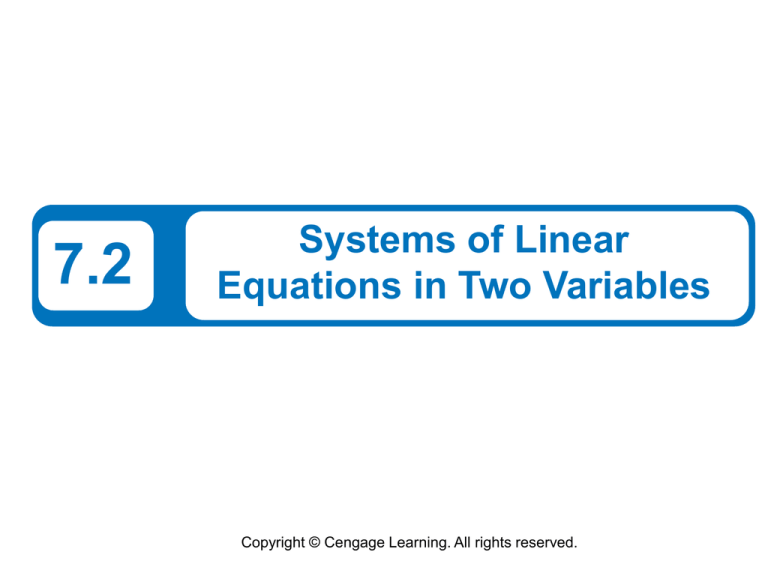
7.2
Systems of Linear
Equations in Two Variables
Copyright © Cengage Learning. All rights reserved.
What You Should Learn
•
•
•
•
Use the method of elimination to solve systems
of linear equations in two variables.
Graphically interpret the number of solutions of
a system of linear equations in two variables.
Use systems of linear equations in two
variables to model and solve real-life problems.
Please read all slides, but focus on 11-20 for
the number of solutions and word problems!!!
2
The Method of Elimination
3
The Method of Elimination
Now we will study the method of elimination to solve a
system of linear equations in two variables. The key step in
this method is to obtain, for one of the variables,
coefficients that differ only in sign so that adding the
equations eliminates the variable.
3x + 5y = 7
– 3x – 2y = – 1
3y = 6
Equation 1
Equation 2
Add equations.
4
The Method of Elimination
Note that by adding the two equations, you eliminate the
x-terms and obtain a single equation in y. Solving this
equation for y produces
y=2
which you can then back-substitute into one of the original
equations to solve for x.
5
Example 1 – Solving a System by Elimination
Solve the system of linear equations.
Equation 1
Equation 2
Solution:
Because the coefficients of y differ only in sign, you can
eliminate the y-terms by adding the two equations.
3x + 2y = 4
5x – 2y = 8
8x
= 12
x
=
Write Equation 1.
Write Equation 2.
Add equations
Solve for x
6
Example 1 – Solution
cont’d
So, x = . By back-substituting into Equation 1, you can
solve for y.
3x + 2y = 4
3
Write Equation 1
+ 2y = 4
Substitute
y=
Solve for y
for x
The solution is
You can check the solution algebraically by substituting into
the original system.
7
Example 1 – Solution
cont’d
Check
Substitute into Equation 1
Equation 1 checks
Substitute into Equation 2
Equation 2 checks
8
The Method of Elimination
9
Graphical Interpretation of
Two-Variable Systems
10
Graphical Interpretation of Two-Variable Systems
It is possible for any system of equations to have exactly
one solution, two or more solutions, or no solution.
If a system of linear equations has two different solutions,
then it must have an infinite number of solutions.
To see why this is true, consider the following graphical
interpretations of a system of two linear equations in two
variables.
11
Graphical Interpretation of Two-Variable Systems
A system of linear equations is consistent when it has at
least one solution. It is inconsistent when it has no
solution.
12
Example 3 – Recognizing Graphs of Linear Systems
Match each system of linear equations (a, b, c) with its
graph (i, ii, iii) in Figure 7.10. Describe the number of
solutions. Then state whether the system is consistent or
inconsistent.
i.
ii.
Figure 7.10
iii.
13
Example 3 – Solution
Begin by rewriting each system of equations in slopeintercept form.
a. The graph of system (a) is a pair of parallel lines (ii).
The lines have no point of intersection, so the system
has no solution. The system is inconsistent.
b. The graph of system (b) is a pair of intersecting lines (iii).
The lines have one point of intersection, so the system
has exactly one solution.
14
Example 3 – Solution
cont’d
The system is consistent.
c. The graph of system (c) is a pair of lines that coincide
(i). The lines have infinitely many points of intersection,
so the system has infinitely many solutions. The system
is consistent.
15
Application
16
Application
At this point, we may be asking the question “How can I tell
which application problems can be solved using a system
of linear equations?” The answer comes from the following
considerations.
1. Does the problem involve more than one unknown
quantity?
2. Are there two (or more) equations or conditions to be
satisfied?
When one or both of these conditions are met, the
appropriate mathematical model for the problem may be a
system of linear equations.
17
Example 6 – Aviation
An airplane flying into a headwind travels the 2000-mile
flying distance between Cleveland, Ohio and Fresno,
California in 4 hours and 24 minutes. On the return flight,
the same distance is traveled in 4 hours. Find the airspeed
of the plane and the speed of the wind, assuming that both
remain constant.
Solution:
The two unknown quantities are the speeds of the wind and
the plane. If r1 is the speed of the plane and r2 is the speed
of the wind, then
r1 – r2 = speed of the plane against the wind
18
Example 6 – Solution
cont’d
r1 + r2 = speed of the plane with the wind
as shown in Figure 7.13.
Figure 7.13
19
Example 6 – Solution
cont’d
Using the formula
distance = (rate) (time)
for these two speeds, you obtain the following equations.
2000 = (r1+ r2 )(4)
These two equations simplify as follows.
Equation 1
Equation 2
20
Example 6 – Solution
cont’d
To solve this system by elimination, multiply Equation 2 by
11.
Write Equation 1
Multiply Equation 2
by 11
Add Equations
So,
Speed of plane
and
Speed of wind
21

